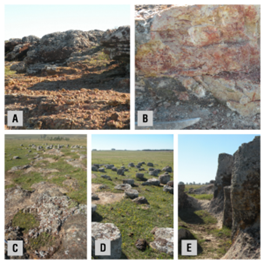Characterization of the parent materials in agricultural soils in the area of Carlos Reyles, Durazno
DOI:
https://doi.org/10.31285/AGRO.26.503Keywords:
parent material, clay, microrelief, diagenesisAbstract
The objective of this work is to determine the parent material of the area of Carlos Reyles, Durazno, as well as the rest of the area and its relation with the local geology. We studied four different places where geological survey was performed as well as sampling of horizons C. For the horizons C we estimated the size of the mineral particles by using the Bouyoucos method and X Ray Diffraction to quantify the mineral composition and the kind of dominant clay mineral. For the main representative lithologies we made thin sections for a better visualization in the petrographic microscope. These indicate, for the different lithologies, a similar composition and distribution of minerals, having as differences between them that they were affected by subsequent diagenetic processes. With respect to the gilgai microrelief, the parent material is a fine sandstone showing a silty-clayey matrix, which had not been reported in the area so far, associated with sandy levels of the Fray Bentos Formation. The C horizons show similar features to the sampled outcrops, both for the East and West of the study area. In the East, the resulting soil is sandy, grayish brown in color, and exhibits varying depths (70-100 cm), with a dominant mineralogy composed of quartz, plagioclase, potassium feldspar and little to very little clay, where the dominant clay mineral is the kaolinite. For the West zone, where the gilgai microrelief occurs, the resulting soils are deeper (>100 cm), dark, with a higher clay content with respect to the eastern area. The dominant mineralogy in the C-horizon is composed of quartz and plagioclase, with a medium proportion of clay. In the areas of these sites where the microrelief is not recognized, the mineralogy of C horizons is similar to those observed for the southern part of the West zone. The dominant clay minerals of the clay fraction of every C horizon in this area belong mainly to the smectite group.
Downloads
References
Alonso-Zarza AM, Genise JF, Verde M. Sedimentology, diagenesis and ichnology of Cretaceous and Palaeogene calcretes and palustrine carbonates from Uruguay. Sediment Geol. 2011;236(1-2):45-61.
Bossi J, Navarro R. Geología del Uruguay. Montevideo: Universidad de la República; 1988. 2v.
Bossi J. Geología del Uruguay. Montevideo: Universidad de la República; 1966. 464p.
Bossi J, Ferrando L. Carta Geológica del Uruguay a escala 1/500.000. Montevideo: Geoeditores; 2001. 1 CD-ROM.
Caorsi J, Goñi J. Geología Uruguaya. Boletín del Instituto Geológico del Uruguay. 1958;(37):75p.
Durán A, García Préchac F. Suelos del Uruguay: origen, clasificación, manejo y conservación. Vol.1. Montevideo: Editorial Hemisferio Sur; 2007. 334p.
Ford I. Carta geológica del Uruguay escala 1/100.000: hoja K-19 Molles. Montevideo: Facultad de Agronomía; 1990. 1 mapa.
Ford I, Gancio F. Asociación caolinita-montmorillonita en un paleosuelo del terciario inferior del Uruguay (Formación Asencio). Boletín de investigación (Facultad de Agronomía). 1988;(12):12p.
Ford I, Gancio F. Carta geológica del Uruguay escala 1/100.000: hoja N-16 Algorta. Montevideo: Facultad de Agronomía; 1990. 1 mapa.
Genise JF, Bellosi ES, Verde M, González MG. Large ferruginized palaeorhizospheres from a Paleogene lateritic profile of Uruguay. Sediment Geol. 2011;240(3-4):85-96.
Gisbert Blanquer J, Ibáñez Asensio S, Moreno Ramón H. Vertisoles [Internet]. Valencia: Universidad Politécnica de Valencia; 2011 [cited 2021 Sep 20]. 6p. Available from: https://bit.ly/3Axi4YA.
Goso CA, Perea D. El Cretácico post-basáltico de la Cuenca Litoral del Río Uruguay: geología y paleontología. In: Veroslavski G, Ubilla M, Martínez S, editors. Cuencas Sedimentarias de Uruguay: geología, paleontología y recursos naturales: Mesozoico. Montevideo: Universidad de la República; 2003. p. 141-69.
Pazos P, Tófalo OR, González M. La paelosuperficie Yapeyú: significado estratigráfico y paleoambiental en la evolución del Cretácico Superior del Uruguay. In: Segundo Congreso Uruguayo de Geología. Punta del Este: Sociedad Uruguaya de Geología; 1998. p. 59-63.
Perea D, Soto M, Montenegro F, Corona A. Nuevo hallazgo de restos de titanosaurios (Dinosauria. Sauropoda) en la Formación Mercedes (Cretácico tardío), Uruguay. Ameghiniana. 2009;46:42R.

Published
How to Cite
Issue
Section
License
Copyright (c) 2022 Agrociencia Uruguay

This work is licensed under a Creative Commons Attribution 4.0 International License.
| Article metrics | |
|---|---|
| Abstract views | |
| Galley vies | |
| PDF Views | |
| HTML views | |
| Other views | |















